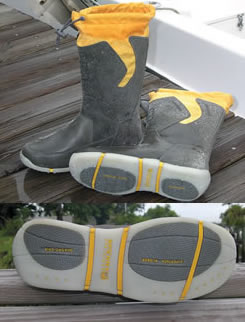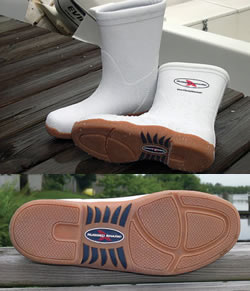August 04, 2014
By Florida Sportsman Staff
Modern deck boots enhance safety and comfort.

High-top boots with cinch strings keep water out and the non-skid sole helps keep both feet on the deck.
|
Dry feet are a hot commodity on a fishing deck awash in chilly water. Ask any seasoned bluewater fisherman or mate. Keeping toes warm and toasty goes a long way when big seas are splashing over the gunnel while the skipper's backing down on a hot fish. Or anywhere your feet can get wet for that matter.
Several years ago, standard footgear was white, PVC boots that offered little in the way of comfort—except for keeping feet dry. Boots with arch supports, higher calf length, built-in insulation and top drawstrings to help prevent leakage around the boot's collar were few and far between.
Times have changed and so have boots. First and foremost among improved features are grooved, wet-grip soles. Rubber boots made for concrete work or sloshing through the marsh have few practical cockpit benefits. Not having the right non-skid tread on a deck boot is a sure recipe for disaster, battered body parts and bruised egos.
Most deck boots now on the market utilize the same type of boat sole—a non-skid, non-marking, razor-cut design popular on ordinary deck shoes. Many makers also wrap the non-slip sole to the boot's rubber upper. That way, they grip in the corners or when you're off balance billing a fish in sloppy seas. Manufacturers market their soles under different names. A few to watch for are “groove and channel,” “quadro-grip wave-siping” and “razor-cut.” All disperse water from the tread to improve grip. Some are even advertised to “grip wet decks like a Ferrari on a tight curve.”

Low-top, 11-inch boots slip on and off easily. Improved soles with arch support are easy on the feet.
|
Want to climb a tower or flybridge ladders without slipping? Molded-in ribs and panels in the sole's recessed arch grab ladder rungs, enabling you to scamper up safely. I remember the first time I ascended a wet ladder wearing the old-style rubber boots. It felt like I was ice skating, only dozens of feet above a rolling deck. Not a feat this Florida boy ever cares to perform again.
Another feature sure to keep your feet comfortable on long days is ergonomic support, in the form of contoured footbeds and something long missing in deck boots—arch support. Cradling feet in the same manner as well-fitting shoes reduces strain and shock.
Removable, cushioned insoles, midsoles and padded uppers are built to catch the heat and keep it there, at the same time, wicking away warmth-robbing moisture. Removable, washable insoles come in several materials with shearling, cotton, quick-drying polyester and Dri-Lex being the most common. Combined with a double layer of socks, either wool or cotton with a thin pair of wicking socks, your feet should stay dry and toasty—as long as you don't jump overboard or a hot marlin doesn't pull the chair off the deck with you still strapped in.
When comparing deck boots, you'll notice many come in two calf heights—11 and 16 inches. The shorter boots are easier to take on and off, but don't provide as much “overflow” protection on a flooded deck. Likewise, 16-inch styles afford more wading ability, but they're harder to jump in and out of. Some also come with strings that cinch the boot's collar tight to your leg to keep water from seeping in. Which model is best for you depends on what you like, the conditions you fish and the mean outside temperature.
Boot uppers are made with several materials, with natural and vulcanized rubber the most common. Other materials include modern “rip-stop,” nylon-type fabrics and leather. As a rule, Florida anglers can get by with rubber uppers, even during the coldest months. Nylon uppers reduce weight, but may not weather repeated seasons as well as rubber versions. Waterproof leather uppers are designed for combating the coldest conditions—something that not many Florida anglers face unless on a winter tuna trip off the Outer Banks.
Deck boots may be the most important aspect of your complete foul-weather garb. Don't get caught out at sea with cold, wet feet or stuck in a pair of uncomfortable, heavy clod-hoppers. The choice is yours.
FS
Shopper's Guide to Shoes
Sperry Topsider
www.sperrytopsider.com
Figawi Foul Weather boots
Rugged Shark
www.ruggedshark.com
Great White Deck Boots
Pro Line Mfg
www.prolineboots.com
Yachting boots 385M and 285M
Henri Lloyd
www.henrilloyd.com
Premier Yacht Deck and Extreme Deck boots
Gill Boots
www.gillna.com
Skiff and Yachting boots
West Marine
www.westmarine.com
16" Offshore Boots, Gill Boots
Boater's World
www.boatersworld.com
Tall Cruising Boots, Gill Boots
BoatUS
www.boatus.com
Offshore Boots, Henri Lloyd
FS Classics
